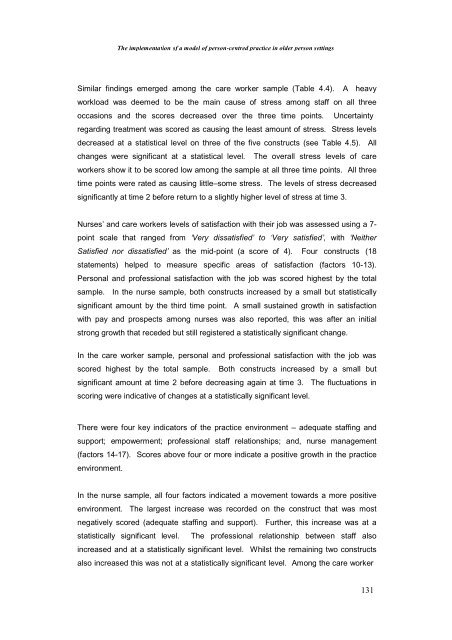The Implementation of a Model of Person-Centred Practice In Older ...
The Implementation of a Model of Person-Centred Practice In Older ...
The Implementation of a Model of Person-Centred Practice In Older ...
Create successful ePaper yourself
Turn your PDF publications into a flip-book with our unique Google optimized e-Paper software.
<strong>The</strong> implementation <strong>of</strong> a model <strong>of</strong> person-centred practice in older person settings<br />
Similar findings emerged among the care worker sample (Table 4.4). A heavy<br />
workload was deemed to be the main cause <strong>of</strong> stress among staff on all three<br />
occasions and the scores decreased over the three time points. Uncertainty<br />
regarding treatment was scored as causing the least amount <strong>of</strong> stress. Stress levels<br />
decreased at a statistical level on three <strong>of</strong> the five constructs (see Table 4.5). All<br />
changes were significant at a statistical level. <strong>The</strong> overall stress levels <strong>of</strong> care<br />
workers show it to be scored low among the sample at all three time points. All three<br />
time points were rated as causing little–some stress. <strong>The</strong> levels <strong>of</strong> stress decreased<br />
significantly at time 2 before return to a slightly higher level <strong>of</strong> stress at time 3.<br />
Nurses’ and care workers levels <strong>of</strong> satisfaction with their job was assessed using a 7-<br />
point scale that ranged from ‘Very dissatisfied’ to ‘Very satisfied’, with ‘Neither<br />
Satisfied nor dissatisfied’ as the mid-point (a score <strong>of</strong> 4). Four constructs (18<br />
statements) helped to measure specific areas <strong>of</strong> satisfaction (factors 10-13).<br />
<strong>Person</strong>al and pr<strong>of</strong>essional satisfaction with the job was scored highest by the total<br />
sample. <strong>In</strong> the nurse sample, both constructs increased by a small but statistically<br />
significant amount by the third time point. A small sustained growth in satisfaction<br />
with pay and prospects among nurses was also reported, this was after an initial<br />
strong growth that receded but still registered a statistically significant change.<br />
<strong>In</strong> the care worker sample, personal and pr<strong>of</strong>essional satisfaction with the job was<br />
scored highest by the total sample. Both constructs increased by a small but<br />
significant amount at time 2 before decreasing again at time 3. <strong>The</strong> fluctuations in<br />
scoring were indicative <strong>of</strong> changes at a statistically significant level.<br />
<strong>The</strong>re were four key indicators <strong>of</strong> the practice environment – adequate staffing and<br />
support; empowerment; pr<strong>of</strong>essional staff relationships; and, nurse management<br />
(factors 14-17). Scores above four or more indicate a positive growth in the practice<br />
environment.<br />
<strong>In</strong> the nurse sample, all four factors indicated a movement towards a more positive<br />
environment. <strong>The</strong> largest increase was recorded on the construct that was most<br />
negatively scored (adequate staffing and support). Further, this increase was at a<br />
statistically significant level. <strong>The</strong> pr<strong>of</strong>essional relationship between staff also<br />
increased and at a statistically significant level. Whilst the remaining two constructs<br />
also increased this was not at a statistically significant level. Among the care worker<br />
131
















